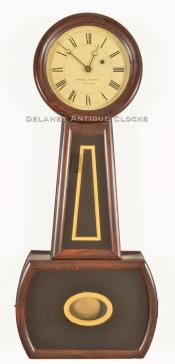Howard & Davis Model No. 4 wall clock. Boston, Massachusetts. A. Howard die-stamp. Timepiece. XX-37.
This very attractive banjo model No. 4 was made by the Howard & Davis Company of Boston, Massachusetts. This is one of five individual banjo models or sizes that this firm manufactured. This model measures approximately 32 inches in length, the lower box is 14 inches across, and the dial is 8 inches in diameter. As a result, this is the second smallest example offered. The smallest size offered by this firm was the Model No. 5, measuring 29 inches long and 12 inches wide in the lower box and has a dial that measures 7 inches in diameter. The largest of the five models is the No. 1 Regulator. This clock is approximately 50 inches long, 20 inches wide across the lower box, and features a 12-inch diameter dial. All five models are traditionally constructed in cherry wood, and the front surfaces are grained with ink to simulate the vibrant pattern found in rosewood.
This is an attractive wall clock. It is often referred to as a banjo clock, but the catalog name is the Model Number 4, and it was marketed as a "Counting-Room and House Clock." This case is constructed in cherry wood. The outer surfaces retain their original grain-painted decoration. This remains in excellent original condition. (The grain pattern simulates the grain pattern exhibited in rosewood.) The original finish is in very good condition. The throat and lower box frames are fitted with painted tablets or glasses. They are decorated from the back in the traditional Company colors of black and gold. The gold appears to be original. The black paint behind it has been restored. In the upper section is the clock's dial. This is an original dial, and it is in excellent condition. The dial is paper. The paper is glued to a zinc pan and measures 8 inches in diameter. It is very nicely signed on the front in block lettering. It reads "HOWARD & DAVIS / BOSTON." The movement is very well made. The heavy brass plates ensure durability. The front plate of this movement is stamped "A. HOWARD / BOSTON." (See the A. Howard reference below.) The wheels are made from cast brass and have been hammered. The gear teeth are finely cut. The pinions and pivots are of the best-cast steel. The escapement is a recoil format. A cast iron weight powers it. The pendulum hangs from the bridge that is mounted to the front of the movement. The seasoned wooden rod is painted black and supports the brass-faced pendulum bob. The motion of this bob can be viewed through the oval aperture in the lower glass.
This very nice example was made circa 1855.
Albert Howard was born in Hingham, Massachusetts, on May 20, 1833, and died in Dorchester, MA, on January 1, 1893. He was a cousin of Edward Howard's and trained in the clock balance factory of Howard & Davis. In fact, he spent most of his working career involved with the various Howard Clock Companies. At the age of 22, he is listed in the Massachusetts Census as a clockmaker living in Roxbury. In 1857-58, he is listed in the Boston Directories as a clock and balance maker located at 109 Washington Street. It is interesting to note that this is also the same address that Samuel Curtis and Edward Howard listed as their address during this year. In 1858, he was again listed but as a "Clockmaker at Edward Howard's." He married Susan Kingman in Boston on May 11, 1859. In 1881, Albert became the general manager of the E. Howard Watch & Clock Company, and at the time of his death, he was the superintendent.
Several wall clock examples are known to be signed by this Maker. A small number of clocks signed Howard & Davis and E. Howard are found with his die-stamp on the movement.
Inventory number XX-37.
The Howard & Davis firm was formed in Boston, Massachusetts, by Edward Howard and David Porter Davis in 1842. Both men were trained and served their apprenticeship in clockmaking to Aaron Willard Jr. of Roxbury, Massachusetts. Their partnership lasted approximately ten years. From 1844 through 1847, Luther S. Stephenson joined the partnership, which was then called Stephenson, Howard & Davis. It is now currently thought that the Howard & Davis name was only used after Stephenson departed. The Howard & Davis Clock Company was located at No 34 Water Street. Here they built a reputation for building very high-quality items, which included various forms of high-grade clocks and precision balances or scales. Banks used gold standard balances. Letter balances were built under contract for the United States Government. These were used in state and county offices. Town standards (scales) and Druggist's balances were also manufactured along with the necessary weights. The company also made sewing machines and fire pumpers. In 1857, the Howard & Davis firm was dissolved when D. P. Davis left to pursue other ventures. In 1857, Davis was part of Davis, Polsey & Co. This firm identified itself as the "late Howard and Davis." They manufactured clocks and a line of pull cord, pin registration watch clocks. This firm lasted until 1860. Posley continued to make these clocks on his own. In 1858, E. Howard began to sign his clocks, E. Howard & Co. This firm enjoyed many prosperous years making clocks and later watches until he retired in 1881.














